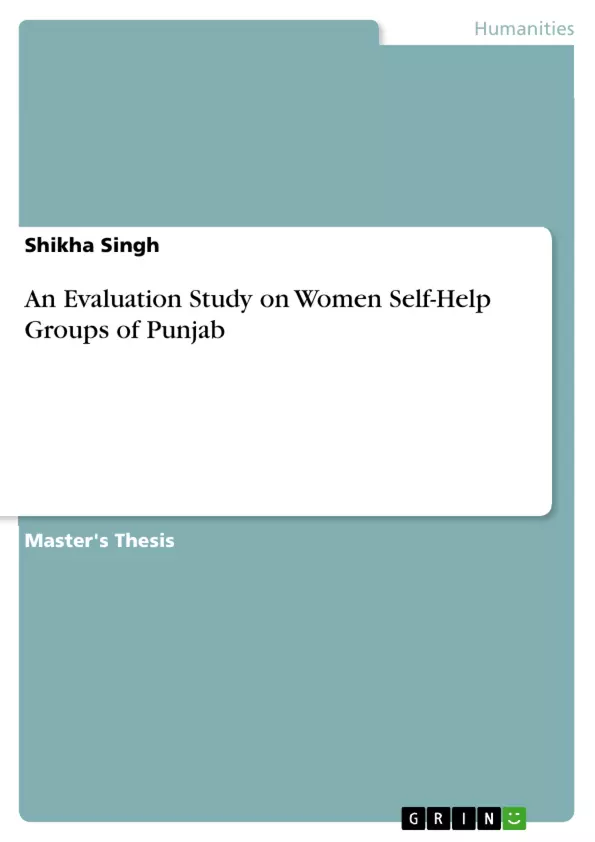This study entitled “An evaluative Study on Women Self Help Groups of Punjab” was undertaken to study the profile and functioning of SHGs, know the opinion of officials/SHG members towards functioning of SHGs, asses the impact of SHGs on empowerment of women and identify the problems experienced by SHG members.
A sample of 150 members i.e. 75 from Ludhiana and 75 from Hoshiarpur were selected through random sampling technique. The data were collected with the help of interview schedule. The study revealed that majority of the SHGs were formed during the year 2008-09, had 16-20 members in their SHGs and were involved in 4-6 entrepreneurial activities. Majority of the SHGs adopted monthly pattern of meeting and found regular in their contribution towards saving.
The findings of the study also indicated that majority of the SHGs were charging interest on inter-loaning among members. Maximum numbers of SHGs were involved in food processing and beauty parlour, their major source of funding for running the enterprise was contributions made by the members. Findings further revealed that all the respondents indicated that SHGs had helped them to undertake income generating activities, set up micro-enterprise, improve availability of financial services and develop habit of saving. All officials agreed that SHGs helped them to undertake income generating activities to set up micro-enterprise with improved availability of financial services and have developed habit of savings. Majority of the respondents reported that there was improvement in economic resources of the family, women‟s own development, decision making regarding education, marriage of children and participation in social activities. Majority of the respondents achieved high level of empowerment through Self-Help Groups. The major problems experienced by members were lack of training opportunity and lack of guidance/ support from promoting agencies.
Inhaltsverzeichnis (Table of Contents)
- CHAPTER I
- INTRODUCTION
- 1.1 Evolution of SHGs in India
- 1.2 Self-help group approach to women empowerment
- CHAPTER II
- REVIEW OF LITERATURE
- 2.1 Profile of SHG members and functioning of SHGs
- 2.2 Impact of SHGs on its members:
- 2.3 Problems faced by SHGS
- CHAPTER III
- MATERIAL AND METHODS
- 3.1 Locale of the study
- 3.2 Selection of districts
- 3.3 Selection of SHGs
- 3.4 Selection of sample
- SAMPLING PLAN FOR THE STUDY
- 3.5 Operational definitions and measurement of variables:
- 3.5.1 Independent variables.
- 3.6 Construction of research tools:
- 3.7 Pre-testing of the research instrument
- 3.8 Collection of data
- 3.9 Analysis of data
- CHAPTER IV
- RESULTS AND DISCUSSION
- 4.1 Profile of SHGs
- 4.2 Socio-economic profile of the SHG members
- 4.3 Functioning of SHGs
- 4.3.1 Criteria to select group leader:
- 4.3.2 Performance of various duties
- 4.3.3 Meetings
- 4.3.4 Distribution of members according to nature of contribution toward savings.
- 4.3.5 Distribution of members according to the loan taken from SHG
- 4.3.6 Distribution of SHGs according to entrepreneurial activities
- 4.3.7 Factors influencing choice of enterprise
- 4.4 Opinion of members and officials towards functioning of SHGS
- 4.4.1 Opinion of members about SHGS
- 4.4.2 Opinion of officials about SHGS
- 4.5 Empowerment of women through SHGs
- 4.6 Problem faced by SHG members
- CHAPTER V
- SUMMARY
Zielsetzung und Themenschwerpunkte (Objectives and Key Themes)
This thesis aims to evaluate the profile and functioning of Women Self-Help Groups (SHGs) in Punjab, assess the impact of SHGs on the empowerment of women, and identify the challenges faced by SHG members. The study analyzes data from 150 SHG members in Ludhiana and Hoshiarpur using interview schedules.
- Profile and Functioning of SHGs
- Impact of SHGs on Women's Empowerment
- Challenges Faced by SHG Members
- Role of SHGs in Financial Inclusion and Micro-Enterprise Development
- Socio-economic Impact of SHGs on Families and Communities
Zusammenfassung der Kapitel (Chapter Summaries)
- Chapter I: Introduction This chapter provides a comprehensive overview of the evolution of SHGs in India and the concept of using self-help groups as a strategy for women's empowerment. It lays the foundation for understanding the importance of SHGs in the context of social and economic development.
- Chapter II: Review of Literature This chapter delves into existing research related to SHGs, examining the profile of SHG members, the functioning of SHGs, and their impact on members. It also explores the challenges faced by SHGs and the various strategies employed to overcome them.
- Chapter III: Material and Methods This chapter details the methodology used in the study, including the locale, sampling techniques, operational definitions, research tools, data collection methods, and data analysis procedures.
- Chapter IV: Results and Discussion This chapter presents the findings of the research, analyzing the profile of SHGs, the socio-economic profile of SHG members, and the functioning of SHGs. It also examines the opinions of SHG members and officials regarding their effectiveness and explores the level of empowerment achieved by women through their participation in SHGs. Finally, it identifies the major problems faced by SHG members.
Schlüsselwörter (Keywords)
This research focuses on the multifaceted role of Self-Help Groups (SHGs) in Punjab, examining their impact on women's empowerment, economic development, and social change. The study explores key themes such as financial inclusion, micro-enterprise development, decision-making power, and the challenges faced by women in rural communities. The research aims to contribute to the understanding of SHGs as a tool for empowering marginalized groups and fostering sustainable development.
- Arbeit zitieren
- Shikha Singh (Autor:in), 2012, An Evaluation Study on Women Self-Help Groups of Punjab, München, GRIN Verlag, https://www.grin.com/document/456195



